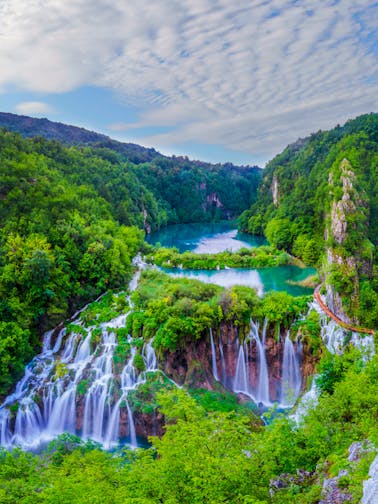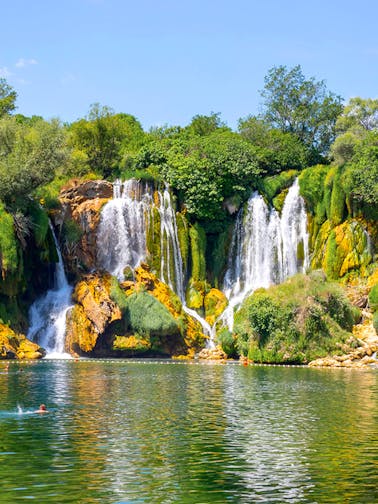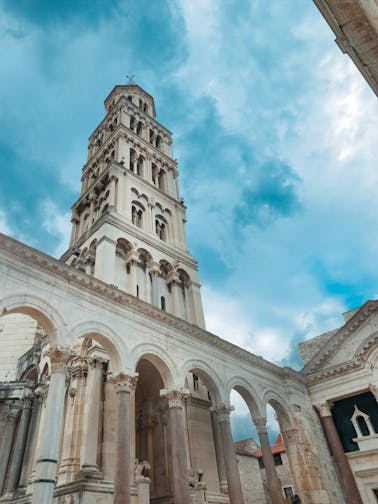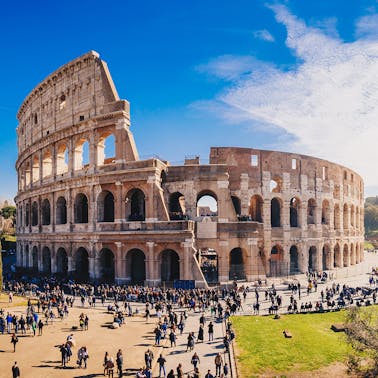Krka National Park Tickets
Explore Krka National Park. Witness breathtaking waterfalls and diverse wildlife. Dive into nature with our Krka National Park Tours.
1.3K+ travellers love this
See what they have to say
Visitor's guide
Must-see highlights & key info

-
Spend the day at Krka with scenic entry by boat along the river, a quick bus ride through Lozovac, or a walk-in route—each offering a unique view of the landscape.
-
Choose between a 2-hour self-guided visit or a full-day guided tour in English, with entry to Skradinski Buk and access to the surrounding trails.
-
Walk the wooden trails around Skradinski Buk and take in the cascading waterfalls, forest views, and natural pools at your own pace.
-
Relax in the riverside town of Skradin, where you can swim, enjoy lunch by the water, or simply take in the scenic views before heading back to Split.
-
Upgrade to a guided day trip from Split with AC transfers for a seamless, all-in-one experience.
More details
-
Spend the day at Krka with scenic entry by boat along the river, a quick bus ride through Lozovac, or a walk-in route—each offering a unique view of the landscape.
-
Choose between a 2-hour self-guided visit or a full-day guided tour in English, with entry to Skradinski Buk and access to the surrounding trails.
-
Walk the wooden trails around Skradinski Buk and take in the cascading waterfalls, forest views, and natural pools at your own pace.
-
Relax in the riverside town of Skradin, where you can swim, enjoy lunch by the water, or simply take in the scenic views before heading back to Split.
-
Upgrade to a guided day trip from Split with AC transfers for a seamless, all-in-one experience.
-
Venture into the heart of Croatia's natural treasure, Krka National Park, on a full-day guided tour brimming with stunning waterfalls, lush greenery, and diverse wildlife.
-
The tour includes a comfortable air-conditioned transfer, amidst the park's landscapes where you will see the Jaruga hydroelectric power plant below the Skradinski Buk.
-
This isn't just a walking tour but an experience where you get to hop on a half-hour boat ride to the nearby harbor of Skradin.
-
Bring out your swimwear to dip into the crystal-clear waters specifically the side where the seawater meets the river. It is quite a unique experience!
-
Fun fact: The park houses the Krka Monastery, an important spiritual center of the Orthodox faith, dating back to the 14th century.
More details
-
Venture into the heart of Croatia's natural treasure, Krka National Park, on a full-day guided tour brimming with stunning waterfalls, lush greenery, and diverse wildlife.
-
The tour includes a comfortable air-conditioned transfer, amidst the park's landscapes where you will see the Jaruga hydroelectric power plant below the Skradinski Buk.
-
This isn't just a walking tour but an experience where you get to hop on a half-hour boat ride to the nearby harbor of Skradin.
-
Bring out your swimwear to dip into the crystal-clear waters specifically the side where the seawater meets the river. It is quite a unique experience!
-
Fun fact: The park houses the Krka Monastery, an important spiritual center of the Orthodox faith, dating back to the 14th century.
-
Relish local wines at the winery, and visit the waterfalls of Skrandinski Buk within Krka National Park on this full-day tour.
-
You're off to a comfortable start with AC transfers and an English-speaking guide who will take you to centuries-old water mills and stone houses.
-
Post your break with nature, a panoramic boat ride to Skradin awaits you! You will then get to sip on three delicious wines of the region - Maraština, Debit, and Plavina.
-
Upgrade your ticket to include a visit to the Krka National Park, and surround yourself with nature, flora, and fauna in this well-preserved environment.
-
Fun fact: Croatia is one of the six leading olive oil producers in the world, and you can taste it on this tour.
More details
-
Relish local wines at the winery, and visit the waterfalls of Skrandinski Buk within Krka National Park on this full-day tour.
-
You're off to a comfortable start with AC transfers and an English-speaking guide who will take you to centuries-old water mills and stone houses.
-
Post your break with nature, a panoramic boat ride to Skradin awaits you! You will then get to sip on three delicious wines of the region - Maraština, Debit, and Plavina.
-
Upgrade your ticket to include a visit to the Krka National Park, and surround yourself with nature, flora, and fauna in this well-preserved environment.
-
Fun fact: Croatia is one of the six leading olive oil producers in the world, and you can taste it on this tour.
-
Explore the Krka National Park and get awed by its beauty with a professional tour guide.
-
Visit the famous Skradinski buk which is the largest travertine barrier in Europe.
-
Learn about the culture and history of Croatia as you stroll through the Krka national Park and the nearby localities.
-
Relax in a half an hour boat ride across the Krka river.
-
Be a part of the wine tasting tour and get to taste some of the most wonderful wines made in Croatia.
More details
-
Explore the Krka National Park and get awed by its beauty with a professional tour guide.
-
Visit the famous Skradinski buk which is the largest travertine barrier in Europe.
-
Learn about the culture and history of Croatia as you stroll through the Krka national Park and the nearby localities.
-
Relax in a half an hour boat ride across the Krka river.
-
Be a part of the wine tasting tour and get to taste some of the most wonderful wines made in Croatia.
-
With round-trip transfers from Trogir, embark on a getaway in the Krka National Park to soak in nature, refreshing waterbodies, and greenery.
-
With an expert local guide, go from Trogir to two locales within the park to experience waterfalls, swim, and see age-old watermills.
-
Head to Skradinski Buk waterfall on a walk along a well-designed wooden path, and go down the canyon to reach cascading waterfalls for a good swim.
-
Head to Skadrin by boat and dip into the lower streams here. Upgrade your ticket to include a wine-tasting tour at Plastovo and treat your senses.
-
Did you know? There is a myth surrounding Krka Falls that a giant serpent lived in the river and terrorized the locals.
More details
-
With round-trip transfers from Trogir, embark on a getaway in the Krka National Park to soak in nature, refreshing waterbodies, and greenery.
-
With an expert local guide, go from Trogir to two locales within the park to experience waterfalls, swim, and see age-old watermills.
-
Head to Skradinski Buk waterfall on a walk along a well-designed wooden path, and go down the canyon to reach cascading waterfalls for a good swim.
-
Head to Skadrin by boat and dip into the lower streams here. Upgrade your ticket to include a wine-tasting tour at Plastovo and treat your senses.
-
Did you know? There is a myth surrounding Krka Falls that a giant serpent lived in the river and terrorized the locals.
-
Relax in comfort and leisure at the Krka National Park, as your expert guide ensures you make the most of your day outdoors.
-
Head to the national park in an AC coach starting from Split or Trogir, enjoying the serene views of the countryside.
-
No need to queue up for tickets—your guide's got you covered! Sit back, and enjoy your hassle-free National Park adventure.
-
Wander around and explore the Skradinski Buk, a clear, natural pool, and then unwind in the Krka River.
-
Enjoy a serene boat ride on the sparkling waters of the Krka River and enjoy some delicious wines with a wine-tasting tour.
More details
-
Relax in comfort and leisure at the Krka National Park, as your expert guide ensures you make the most of your day outdoors.
-
Head to the national park in an AC coach starting from Split or Trogir, enjoying the serene views of the countryside.
-
No need to queue up for tickets—your guide's got you covered! Sit back, and enjoy your hassle-free National Park adventure.
-
Wander around and explore the Skradinski Buk, a clear, natural pool, and then unwind in the Krka River.
-
Enjoy a serene boat ride on the sparkling waters of the Krka River and enjoy some delicious wines with a wine-tasting tour.
-
Start your guided tour from Split in an air-conditioned vehicle.
-
Explore the natural surroundings of the Krka National Park, ensuring not to miss the lakes and waterfalls – the biggest waterfall being the Skradinski buk.
-
Visit an authentic eco-village and its attractions such as a museum and blacksmith’s shop.
-
The highlight of this tour is the boat ride to the historic town of Skradin and a beach visit – the perfect way to finish the day.
More details
-
Start your guided tour from Split in an air-conditioned vehicle.
-
Explore the natural surroundings of the Krka National Park, ensuring not to miss the lakes and waterfalls – the biggest waterfall being the Skradinski buk.
-
Visit an authentic eco-village and its attractions such as a museum and blacksmith’s shop.
-
The highlight of this tour is the boat ride to the historic town of Skradin and a beach visit – the perfect way to finish the day.
Pro tips to help you make a pick
Similar things to do in Split
About Krka National Park
One of Croatia’s top attractions, Krka National Park covers 109 square kilometers of pristine wilderness. Explore its 7 waterfalls, ancient monasteries, blue-green waters, and the dramatic Krka River canyon. Located in central Dalmatia, just off the coast of the Adriatic Sea, the park attracts about 1 million visitors each year.

Krka National Park was specifically created to protect the natural landscape, unique biodiversity, and cultural heritage of the Krka River and the surrounding region.

The areas surrounding the waterfalls in the national park have one of the densest concentrations of natural lavender in Europe. As a result, the area has a proportionally high concentration of bees and wasps as well.

The Krka River is not the only river within the national park. A portion of the Čikola River, a tributary of the Krka, is also located within the park’s boundaries.
Why visit Krka National Park?
Highlights
Plan your visit

Lozovac
This is the main entrance to Krka National Park, and the most used by both individual visitors as well as tour groups. From April to October, shuttle buses are available to transport visitors to Skradinski Buk waterfall, or they can hike the scenic 875-meter trail to get there. In winter, visitors can enter with their own vehicles. Free parking is available year-round near this entrance.

Skradin
This is the second most popular entrance to the national park. Boats to the Skradinski Buk waterfall as well as boat tours of the park depart from this entrance. Hiking and bicycle trails also begin from here to the falls and other parts of the park. Do keep in mind that boat transportation to Skradinski Buk and back is available from April to October and closed from November to March. Limited parking facilities are available here.

Roški slap waterfall/Laškovica
This is the closest road entrance to the Roški slap waterfall. From here, you can also take boat tours to Krka Monastery and Visovac Island from April to October. Bus services from Laškovica to Roški slap and the locality of Stinice operate from June to September. Parking is limited but most visitors access the falls by boat, so it is not difficult to find a spot.

Burnum/Puljane
This is the closest entrance to the Burnum archaeological site as well as the Eco Campus in Puljane, where the Burnum archaeological collection is displayed. Keep in mind that while the archaeological collection at the Eco Campus is open all year round, the Burnum amphitheatre is closed from November to February. Visitor parking is available at this entrance.

Kistanje/Krka monastery
This entrance allows you to access the national park through the Krka Monastery, which is located close to Kistanje. You can take boat tours to visit the Roški slap waterfall and a couple of nearby medieval fortresses of Nečven and Trošenj. You can also take the 30-minute educational trail which covers the flora and fauna of the surrounding areas. Parking is available at Krka Monastery.
Visitors need to pay to use most of the restrooms inside the national park. However, free visitor toilets are available near the Ethno village and at the Imperial Viewpoint.
Free parking is available at the Lozovac, Roški slap waterfall/Laškovica, Burnum/Puljane, and Kistanje/Krka monastery entrances.
Paid parking is available for visitors at the Skradin entrance.
Shuttle buses and boat tours are available inside the park from April to October.
The national park is partially accessible by wheelchair. These trails and walkways are clearly marked with signposts. The boats and shuttle buses used in the park also accommodate wheelchairs. However, the steep and uneven walking paths are not wheelchair friendly.
Dogs are allowed inside the national park but must be on the leash and accompanied by their owners at all times. Dogs are not permitted on Visovac Island or inside Krka monastery.
Millions love heading out with us
Nearby cities to explore

























































































